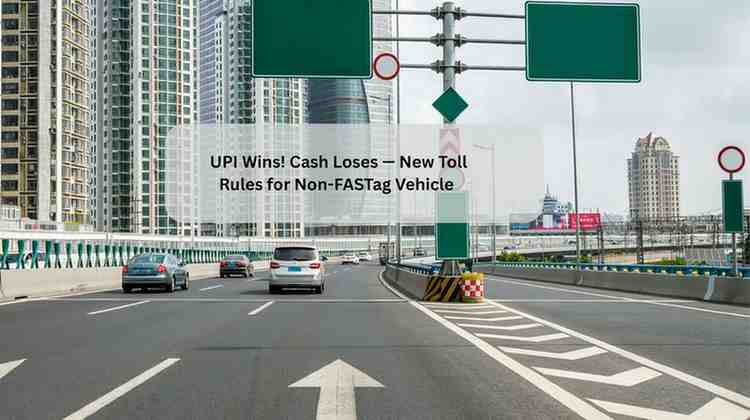Vehicles Without FASTag to Face 1.25x Toll Charge on UPI Payments — Here’s What You Need to Know

If you still haven’t switched to FASTag, here’s a heads-up — the Indian government has just made a big change to how tolls are charged on national highways. Starting November 15, 2025, drivers without a FASTag will have to pay extra at toll plazas. But there’s a catch — if you choose to pay using UPI, you’ll end up paying less than those who pay in cash.
The Ministry of Road Transport and Highways (MoRTH) announced that the rules under the National Highways Fee (Determination of Rates and Collection) Rules, 2008 have been amended to promote digital payments and reduce cash handling at toll booths.
What Changes from November 15, 2025?
Under the new rule, every vehicle entering a toll plaza without a valid or functional FASTag will pay a higher toll based on how they choose to pay:
- 🟢 UPI Payments: You’ll be charged 1.25 times (1.25x) the regular toll.
- 🔴 Cash Payments: You’ll need to pay double (2x) the regular toll.
So, for example, if the normal toll for a car with FASTag is ₹100 —
- Paying by UPI will cost ₹125
- Paying by cash will cost ₹200
This means even if you forget your FASTag, using UPI will still save you some money compared to paying by cash.
Why the Change?
The government’s goal is simple — to make toll payments faster, cleaner, and fully digital. Cash transactions slow down toll queues and create hassles for both drivers and operators.
By giving a small price advantage to digital payment methods like UPI, the Ministry hopes more people will move away from cash and embrace digital India’s vision of smoother, cashless travel experiences.
In its official statement, the Ministry said this amendment will “incentivize digital payments, eliminate cash transactions, and improve transparency in toll operations.”
What Is FASTag and Why You Should Use It
FASTag is an electronic toll payment tag that uses Radio Frequency Identification (RFID) technology. It’s stuck on your vehicle’s windscreen and linked directly to your bank account or prepaid wallet. Whenever your car passes a toll plaza, the system automatically deducts the amount — no need to stop, no need to pay manually.
You can buy a FASTag from:
- Authorized banks like SBI, HDFC, ICICI, etc.
- NHAI toll plazas
- Online platforms such as Paytm, Amazon, or your banking app
Once linked, you can recharge it anytime online through UPI, debit/credit card, or net banking.
Is FASTag Mandatory?
Yes — it’s been mandatory since January 1, 2021, for all four-wheelers and above under the Central Motor Vehicles Rules (CMVR), 1989.
This means every car, SUV, and commercial vehicle carrying goods or passengers must have a valid FASTag to use national highways without penalties.
How Much Does a FASTag Cost?
FASTag fees depend on your bank. Most banks charge a small security deposit and minimum recharge amount when you first get the tag. You can check the ‘Fees and Charges’ section of your bank’s website for the exact details.
Top Benefits of Using FASTag
- 🚦 No need to stop at toll booths — just drive through
- 💸 No cash required or exact change headaches
- ⏱️ Save time and fuel
- 🔄 Easy online recharge via cards, UPI, or net banking
- 📩 Get instant SMS alerts for every transaction and balance
- 🔍 Transparent and hassle-free toll management
Where Is FASTag Accepted?
FASTag works at all national highway toll plazas across India and at several state highway tolls where the system has been implemented.
You can also check your bank’s website or the NHAI FASTag portal to confirm whether your route supports FASTag transactions.
Why the Amendment Matters
This change is more than just about tolls — it’s about transforming how India moves. The new differential charges are expected to:
- Encourage more people to adopt digital payments
- Reduce cash handling and manual errors
- Speed up toll lane movement
- Cut down fuel wastage caused by long queues
Ultimately, it’s another step toward smart and seamless travel on India’s highways.